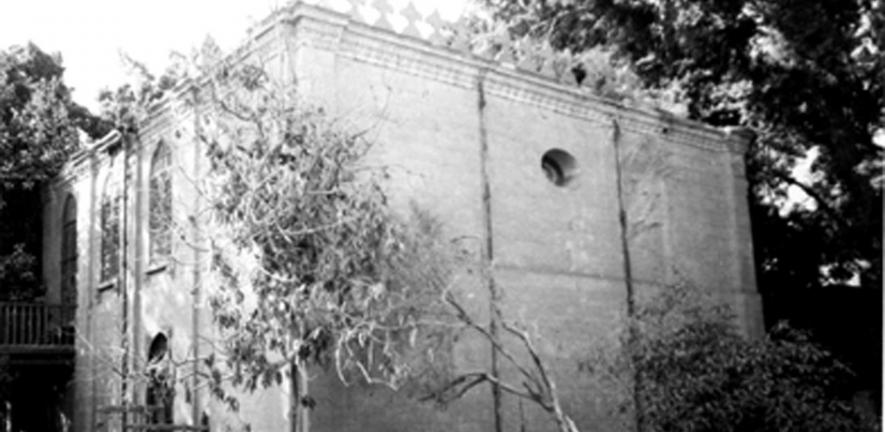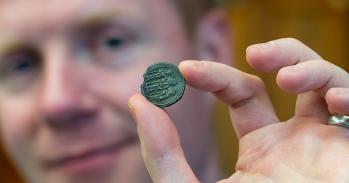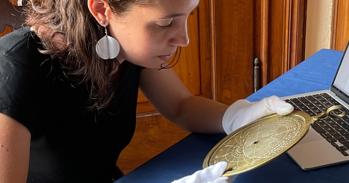
How did an Egyptian storeroom come to hold a thousand years worth of manuscript fragments and why are they one of the greatest literary treasures ever found?
How did an Egyptian storeroom come to hold a thousand years worth of manuscript fragments and why are they one of the greatest literary treasures ever found?
Undated and unsigned, this lowly medieval scrap was nevertheless safeguarded by the Jewish community of Old Cairo for nearly a thousand years.
The single largest and most important collection of medieval Jewish manuscripts in the world, and one of the greatest literary treasures of Cambridge University Library, was recovered from the dusty storeroom, known as a genizah, of an ancient Egyptian synagogue. The fragments, now known as the Taylor-Schechter Genizah Collection, are a treasure-trove of priceless Jewish manuscripts, containing examples of practically every kind of written text produced by the Jewish communities of Cairo, Jerusalem, Damascus and elsewhere over a period of more than 1000 years.
A battlefield of books
The Collection was discovered by Solomon Schechter, the Reader in Talmudic and Rabbinic literature at Cambridge, in 1896. Schechter was shown some leaves of a hitherto unknown Hebrew manuscript of the book of Ben Sira (Ecclesiasticus) by the lady adventurers Mrs Agnes Lewis and Mrs Margaret Gibson who had recently purchased them in Egypt. Quickly realising that there must be more of these important fragments, Schechter arranged to travel to Egypt to locate their source which he already suspected was a synagogue in Fustat, Old Cairo.
Once in Cairo, having established contacts within the local community, Schechter was taken to see the genizah of the 1000-year-old Ben Ezra Synagogue, into which worn-out Jewish books, documents and other writings had continually been placed since the Middle Ages in fulfilment of a rabbinic prohibition against the destruction of sacred texts. Schechter described the scene thus in an article for the The London Times of August 3, 1897: ‘It is a battlefield of books, and the literary productions of many centuries had their share in the battle, and their disjecta membra are now strewn over its area. Some of the belligerents have perished outright, and are literally ground to dust in the terrible struggle for space, whilst others […] are squeezed into big, unshapely lumps.’
Realising the immense scholarly potential of these manuscripts, Schechter obtained the approval of the synagogue authorities to bring them back to Cambridge where they could be carefully conserved and studied. With financial backing from the Master of St John’s College, Charles Taylor, he packed two-thirds of the contents of the genizah into tea-chests and shipped them to England. The Collection was presented to Cambridge University Library in 1898.
Bibles and bills
Great discoveries followed: more leaves from the book of Ben Sira in Hebrew; the first glimpse of an unknown text that would, following its discovery among the Dead Sea Scrolls, become known as the Damascus Document; and dozens of manuscripts written in the hand of some of medieval Judaism’s greatest figures, Moses Maimoindes, Judah ha-Levi, Joseph Karo and Isaac Luria, to name a few. But the unique aspect of this archive is that it preserves the spectacular alongside the quotidian, the sacred alongside the profane, and the ageless alongside ephemera. Butcher’s bills, marriage contracts, private letters and IOUs nestle against invaluable manuscript leaves of the Jerusalem Talmud, rare or unique biblical commentaries and thousands of previously unknown poems by the leading Hebrew poets of Spain and Palestine.
Two examples show this odd amalgam clearly. The Collection has turned up the world’s earliest dated medieval Hebrew manuscript. Cambridge University Library T-S NS 246.26.2 is a small, damaged piece of parchment containing the end of the biblical Book of Nehemiah in a neat eastern script. The scribe, Joseph son of Nimored, ended by writing a colophon in which he stated that it was completed in 1215 in the town of Gunbad-i-Mallgan in Iran. The year 1215, according to the usual medieval practice of dating from the ‘Era of Documents’, the Seleucid Era, equates to 903–4 CE. This ancient text was clearly of considerable value in its own day, since it made the arduous journey from Central Asia to Egypt, where it was eventually, at the end of its useful life, put away in the storeroom, too sacred to heedlessly throw away.
 The other end of the spectrum is represented by CUL T-S Ar.53.65, a particularly scrappy-looking note sent home with an Egyptian Jewish schoolboy, one afternoon in the 11th or 12th century. The teacher points out to the boy’s guardian that because his son has done so well in his classes the other pupils, led by one known, perhaps ironically, as ‘Little Treasure’, ganged up and broke the boy’s writing-board – boards balanced on the knees were used in place of tables. Undated and unsigned, this lowly medieval scrap was nevertheless safeguarded by the Jewish community of Old Cairo for nearly a thousand years. The fragments continue to provide a rich resource today.
The other end of the spectrum is represented by CUL T-S Ar.53.65, a particularly scrappy-looking note sent home with an Egyptian Jewish schoolboy, one afternoon in the 11th or 12th century. The teacher points out to the boy’s guardian that because his son has done so well in his classes the other pupils, led by one known, perhaps ironically, as ‘Little Treasure’, ganged up and broke the boy’s writing-board – boards balanced on the knees were used in place of tables. Undated and unsigned, this lowly medieval scrap was nevertheless safeguarded by the Jewish community of Old Cairo for nearly a thousand years. The fragments continue to provide a rich resource today.
A 21st-century genizah
This spectacular archive has been the subject of intensive work in Cambridge University Library for the past 30 years, since the creation of the Genizah Research Unit in 1974. Reliant upon charitable and research grant funding, the Unit has succeeded in completing the conservation of 193,000 fragments, and continues with an extensive programme of cataloguing, research and public education. Now, thanks to an Arts and Humanities Research Council (AHRC) grant, three Research Associates have begun work describing and digitising 14,000 items from the ‘Old Series’ of the Collection, containing some of the rarest pieces.
The Unit has been digitising manuscripts for over 10 years, and some 30,000 images will be available online by the autumn of 2009 thanks to a previous AHRC grant. This is just a beginning, however, as the US-based Friedberg Genizah Project, together with its sister charity in Canada, the Jewish Manuscripts Preservation Society, has made a substantial grant to the Library to digitise the remainder of the entire Collection – a staggering 310,000 digital images. The high-quality images will be produced over the next three years by the Library’s Imaging Services Department. They will be made available online by both Friedberg and Cambridge, the latter through the University’s digital repository DSpace@Cambridge, which will safely store an estimated 25 terabytes of manuscript images as a 21st-century genizah of its own.
For more information, please contact the author Dr Ben Outhwaite (genizah@lib.cam.ac.uk), Head of the Taylor-Schechter Genizah Research Unit in Cambridge University Library.
This work is licensed under a Creative Commons Licence. If you use this content on your site please link back to this page.





